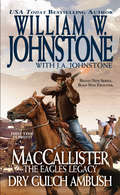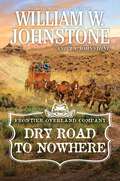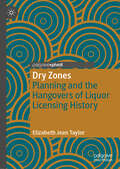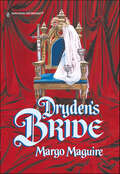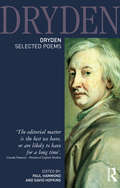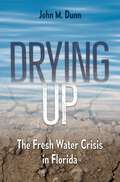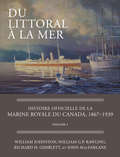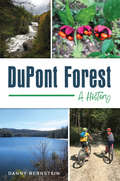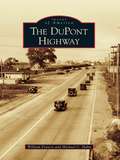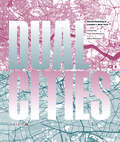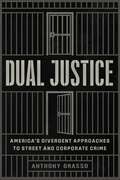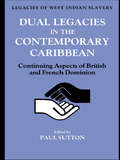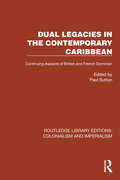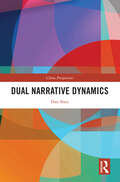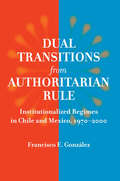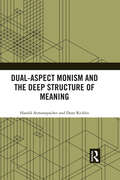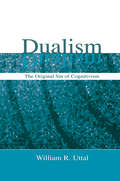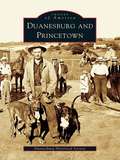- Table View
- List View
Dry Gulch Ambush: Dry Gulch Ambush (A Duff MacCallister Western #3)
by William W. Johnstone J.A. JohnstoneThe Greatest Western Writer Of The 21st CenturyDuff MacCallister is heir to a fierce family of fighting Scotsmen. In a new land, in the extraordinary new saga by bestselling authors William W. Johnstone and J.A. Johnstone, Duff gives new meaning to the words without mercy. Cut Off The Head--The Beast Will Die.The Indians around Fort Laramie, Wyoming are peaceful. Or so it has seemed--until killers ambush a detail of U.S. soldiers and an officer's wife. One man, an ambitious cavalry officer, flees the carnage and lives to tell the story--his own story, an outright lie. When Duff MacCallister and a few brave men go after the attackers, they discover the officer's wife is very much alive and at the cold merciless hands of the sadistic warrior Yellow Hawk. To free the woman, Duff touches off a fierce battle. And when he finds himself surrounded by the blood-crazed renegades, MacCallister knows there is only one way out--by going after Yellow Hawk himself. . . First Time In Print!
Dry Manhattan: Prohibition in New York City
by Michael A. LernerIn 1919, the United States made its boldest attempt at social reform: Prohibition. This "noble experiment" was aggressively promoted, and spectacularly unsuccessful, in New York City. In the first major work on Prohibition in a quarter century, and the only full history of Prohibition in the era's most vibrant city, Lerner describes a battle between competing visions of the United States that encompassed much more than the freedom to drink.
Dry Road to Nowhere (The Frontier Overland Company #2)
by William W. Johnstone J.A. JohnstoneJOHNSTONE COUNTRY. TRAVEL AT YOUR OWN RISK. Some call it the most dangerous stagecoach in the West. But the hard-driving owners of the Frontier Overland Company will get you where you want to go—if you don&’t mind a detour through hell . . . The Civil War is over. But Wyoming Territory is still a battleground for the native tribes who live there. Most folks avoid the area like the plague. But not former Texas Ranger Butch Keeler and his saloon fight buddy Tucker Cobb. They figured Wyoming would be the perfect place to launch the Frontier Overland Company—a rough-and-ready stagecoach operation that dares to go where others fear to tread. Butch and Cobb aren&’t afraid of much—but their next stagecoach trip could change all that. And it just might be their last . . . The passengers are good people: Colonel McBride, who&’s delivering much-needed supplies to Fort Washington, and his lovely niece, who wants to visit her dying father. Even though the road to get there is overrun with armed Lakota, Cheyenne, and other deadly threats, Butch and Cobb are determined to help an old friend. Problem is, their worst enemy—a power-hungry business rival and self-described &“King&”—is out there. Waiting for them. Laying a trap to destroy their operation. And plotting to burn everything to the ground. Over Butch and Cobb&’s dead bodies . . .
Dry Storeroom No. 1
by Richard ForteyDry Store Room No. 1 is an intimate biography of the Natural History Museum, celebrating the eccentric personalities who have peopled it and capturing the wonders of scientific endeavour, academic rigour and imagination. This book is a kind of museum of the mind. It is my own collection, a personal archive, designed to explain what goes on behind the polished doors in the Natural History Museum. The lustre of a museum does not depend only on the artefacts or objects it contains the people who work out of sight are what keeps a museum alive. I want to bring those invisible people into the sunlight. Behind the public facade of any great museum there lies a secret domain: one of unseen galleries, locked doors, priceless specimens and hidden lives. Through the stories of the numerous eccentric individuals whose long careers have left their mark on the study of evolutionary science, Richard Fortey, former senior paleontologist at London's Natural History Museum, celebrates the pioneering work of the Museum from its inception to the present day. He delves into the feuds, affairs, scandals and skulduggery that have punctuated its long history, and formed a backdrop to extraordinary scientific endeavour. He explores the staying power and adaptability of the Museum as it responds to changes wrought by advances in technology and molecular biology -- 'spare' bones from an extinct giant bird suddenly become cutting-edge science with the new knowledge that DNA can be extracted from them, and ancient fish are tested with the latest equipment that is able to measure rises in pollution. Dry Store Room No. 1 is a fascinating and affectionate account of a hidden world of untold treasures, where every fragment tells a story about time past, by a scientist who combines rigorous professional learning with a gift for prose that sparkles with wit and literary sensibility.
Dry Zones: Planning and the Hangovers of Liquor Licensing History
by Elizabeth Jean TaylorThis book tells the story of local-level controls on liquor licensing (‘local option’) that emerged during the anti-alcohol temperance movement of the late 19th and early 20th centuries. It offers a new perspective on these often-overlooked smaller prohibitions, arguing local option not only reshaped the hotel industry but has legacies for, and parallels with, questions facing cities and planners today. These range from idiosyncratic dry areas; to intrinsic ideas of residential amenity and neighbourhood, zoning separation, and objection rights. The book is based on a case study of temperance-era liquor licensing changes in Victoria, their convergence with early planning, and their continuities. Examples are given of contemporary Australian planning debates with historical roots in the temperance era – live music venues, bottle shops, gaming machines, fast food restaurants. Dry Zones uses new archival research and maps; and includes examples from family histories in Harcourt and Barkers Creek, a district with a temperance reputation and which closed all its hotels during the temperance era. Suggesting ‘wowsers’ are not so easily relegated to history books, Taylor reflects on tensions around individual and local rights, localism and centralism, direct democracy, and domestic violence, that continue to be re-enacted. Dry Zones visits a forgotten by-way of licensing history, showing the early 21st century is a useful time to reflect on this history as while some temperance-era controls are being scaled back, similar controls are being put forward for much the same reasons.
Dryden's Bride
by Margo MaguireSir Hugh Dryden undertook his quest for a bride with a guarded heart. But two years of captivity had deadened his desire for any woman. So why, then, did the sight of a mere country girl in distress stir such tenderness in him? And why did simply carrying her from danger set his pulse pounding?Without a proper dowry, no gentleman would ask to marry Sian Tudor. Most made less respectable offers-excepting the knight who'd rescued her from certain death. The man was strong and dangerous looking-and she'd had the most unfamiliar longing to touch him. But what sense were flights of fancy when he was surely bound for battle-and Sian about to be banished to a nunnery...?
Dryden: Selected Poems (Longman Annotated English Poets)
by PAUL HAMMOND; DAVID HOPKINSDryden: Selected Poems is drawn from Paul Hammond and David Hopkins's remarkable five-volume The Poems of John Dryden, and includes a generous selection of his most important work. The great satires, MacFlecknoe and Absalom and Achitophel, are included in full, as are his religious poemsReligio Laici and The Hind and the Panther, along with a number of Dryden's translations from Horace, Ovid, Homer, and Chaucer. Each poem is accompanied by a headnote, which gives details of composition, publication, and reception. The first-rate annotations provide information on matters of interpretation and give details of allusions that might prove baffling to contemporary readers. Some 300 years after his death, Dryden: Selected Poems will enable new generations of readers to discover the poet of whom Eliot wrote: 'we cannot fully enjoy or rightly estimate a hundred years of English poetry unless we fully enjoy Dryden'.
Drying Up: The Fresh Water Crisis in Florida
by John M. DunnAmerica’s wettest state is running out of water. Florida—with its swamps, lakes, extensive coastlines, and legions of life-giving springs—faces a drinking water crisis. Drying Up is a wake-up call and a hard look at what the future holds for those who call Florida home. Journalist and educator John Dunn untangles the many causes of the state’s freshwater problems. Drainage projects, construction, and urbanization, especially in the fragile wetlands of South Florida, have changed and shrunk natural water systems. Pollution, failing infrastructure, increasing outbreaks of toxic algae blooms, and pharmaceutical contamination are worsening water quality. Climate change, sea level rise, and groundwater pumping are spoiling freshwater resources with saltwater intrusion. Because of shortages, fights have broken out over rights to the Apalachicola River, Lake Okeechobee, the Everglades, and other important watersheds. Many scientists think Florida has already passed the tipping point, Dunn warns. Drawing on more than one hundred interviews and years of research, he affirms that soon there will not be enough water to meet demand if “business as usual” prevails. He investigates previous and current restoration efforts as well as proposed future solutions, including the “soft path for water” approach that uses green infrastructure to mimic natural hydrology. As millions of new residents are expected to arrive in Florida in the coming decades, this book is a timely introduction to a problem that will escalate dramatically—and not just in Florida. Dunn cautions that freshwater scarcity is a worldwide trend that can only be tackled effectively with cooperation and single-minded focus by all stakeholders involved—local and federal government, private enterprise, and citizens. He challenges readers to rethink their relationship with water and adopt a new philosophy that compels them to protect the planet’s most precious resource.
Drylongso: A Self-portrait of Black America
by John L. GwaltneyRevealing oral histories of black Americans collected in the 1970's by a blind, African American anthropologist.
Du Pont Dynasty: Behind the Nylon Curtain (Forbidden Bookshelf #6)
by Gerard ColbyAward-winning journalist Gerard Colby takes readers behind the scenes of one of America&’s most powerful and enduring corporations; now with a new introduction by the author Their name is everywhere. America&’s wealthiest industrial family by far and a vast financial power, the Du Ponts, from their mansions in northern Delaware&’s &“Chateau Country,&” have long been leaders in the relentless drive to turn the United States into a plutocracy. The Du Pont story in this country began in 1800. Éleuthère Irénée du Pont, official keeper of the gunpowder of corrupt King Louis XVI, fled from revolutionary France to America. Two years later he founded the gunpowder company that called itself &“America&’s armorer&”—and that President Wilson&’s secretary of war called a &“species of outlaws&” for war profiteering. Du Pont Dynasty introduces many colorful characters, including &“General&” Henry du Pont, who profited from the Civil War to build the Gunpowder Trust, one of the first corporate monopolies; Alfred I. du Pont, betrayed by his cousins and pushed out of the organization, landing in social exile as the powerful &“Count of Florida&”; the three brothers who expanded Du Pont&’s control to General Motors, fought autoworkers&’ right to unionize, and then launched a family tradition of waging campaigns to destroy FDR&’s New Deal regulatory reforms; Governor Pete du Pont, who ran for president and backed Newt Gingrich&’s 1994 Republican Revolution; and Irving S. Shapiro, the architect of Du Pont&’s ongoing campaign to undermine effective environmental regulation. From plans to force President Roosevelt from office, to munitions sales to warlords and the rising Nazis, to Freon&’s damage to the planet&’s life-protecting ozone layer, to the manufacture of deadly gases and the covered-up poisoning of Du Pont workers, to the reputation the company earned for being the worst polluter of America&’s air and water, the Du Pont reign has been dappled with scandal for centuries. Culled from years of painstaking research and interviews, this fully documented book unfolds like a novel. Laying bare the bitter feuds, power plays, smokescreens, and careless unaccountability that erupted in murder, Colby pulls back the curtain on a dynasty whose formidable influence continues to this day. Suppressed in myriad ways and the subject of the author&’s landmark federal lawsuit, Du Pont Dynasty is an essential history of the United States.
Du Pont Dynasty: Behind the Nylon Curtain (Forbidden Bookshelf #6)
by Gerard ColbyAward-winning journalist Gerard Colby takes readers behind the scenes of one of America&’s most powerful and enduring corporations; now with a new introduction by the author Their name is everywhere. America&’s wealthiest industrial family by far and a vast financial power, the Du Ponts, from their mansions in northern Delaware&’s &“Chateau Country,&” have long been leaders in the relentless drive to turn the United States into a plutocracy. The Du Pont story in this country began in 1800. Éleuthère Irénée du Pont, official keeper of the gunpowder of corrupt King Louis XVI, fled from revolutionary France to America. Two years later he founded the gunpowder company that called itself &“America&’s armorer&”—and that President Wilson&’s secretary of war called a &“species of outlaws&” for war profiteering. Du Pont Dynasty introduces many colorful characters, including &“General&” Henry du Pont, who profited from the Civil War to build the Gunpowder Trust, one of the first corporate monopolies; Alfred I. du Pont, betrayed by his cousins and pushed out of the organization, landing in social exile as the powerful &“Count of Florida&”; the three brothers who expanded Du Pont&’s control to General Motors, fought autoworkers&’ right to unionize, and then launched a family tradition of waging campaigns to destroy FDR&’s New Deal regulatory reforms; Governor Pete du Pont, who ran for president and backed Newt Gingrich&’s 1994 Republican Revolution; and Irving S. Shapiro, the architect of Du Pont&’s ongoing campaign to undermine effective environmental regulation. From plans to force President Roosevelt from office, to munitions sales to warlords and the rising Nazis, to Freon&’s damage to the planet&’s life-protecting ozone layer, to the manufacture of deadly gases and the covered-up poisoning of Du Pont workers, to the reputation the company earned for being the worst polluter of America&’s air and water, the Du Pont reign has been dappled with scandal for centuries. Culled from years of painstaking research and interviews, this fully documented book unfolds like a novel. Laying bare the bitter feuds, power plays, smokescreens, and careless unaccountability that erupted in murder, Colby pulls back the curtain on a dynasty whose formidable influence continues to this day. Suppressed in myriad ways and the subject of the author&’s landmark federal lawsuit, Du Pont Dynasty is an essential history of the United States.
Du littoral à la mer: Histoire officielle de la Marine royale du Canada, 1867–1939
by William Johnston Richard H. Gimblett William G.P. Rawling John MacFarlaneLa création de la Marine royale du Canada (MRC) en 1910 et ses premières années d’existence ont été marquées par un débat politique quant à la nécessité d’un service naval au Canada. Du littoral à la mer, le premier d’une série de trois volumes relatant l’histoire officielle de la MRC, retrace les trois premières décennies de la Marine, de ses débuts comme marine de pacotille établie par le Premier ministre sir Wilfrid Laurier et constituée de deux croiseurs britanniques obsolètes jusqu’ à son entrée dans la Seconde Guerre mondiale, en tant que force composée de six destroyers modernes et de quatre dragueurs de mines. L’histoire de la MRC au cours du conflit de 1939-1945 a déjà été raconté dans la partie 1, Rien de plus noble, et la partie 2, Parmi les puissances navales, du volume II de la série, publié précédemment. Fondé sur des recherches archivistiques approfondies, l’ouvrage Du littoral à la mer relate les âpres débats qui ont finalement mené à l’établissement de la MRC en 1910, son existence précaire après le remplacement soudain du gouvernement de Laurier par celui de Robert Borden un an plus tard, ainsi que les difficultés de la Marine au cours de la Première Guerre mondiale lorsqu’elle a dû défendre les eaux canadiennes avec très peu de ressources. Des conséquences désastreuses de la terrible explosion survenue Halifax en décembre 1917 jusqu’à la campagne menée par les sous-marins allemands au large de la côte Est du Canada en 1918, le volume I examine dans quelle mesure les conseils souvent incohérents qu’Ottawa recevait de l’Amirauté britannique, à Londres, ont compliqué la tâche de la MRC. La dernière section de cet important ouvrage historique bien illustré traite de l’expérience de la MRC pendant l’entre-deux-guerres, alors que le sentiment antiguerre et une dépression économique menaçaient sa survie même.
DuPont Forest: A History (Natural History)
by Danny BernsteinDuPont Forest protects thousands of acres of trees, five lakes and more than one hundred miles of multiuse trails. It attracts hikers, equestrians and mountain bikers from all over the United States, and its six waterfalls have been featured in movies like The Hunger Games and The Last of the Mohicans. All of this natural beauty is easily accessible, increasing its appeal. It took not only the generosity of a multinational company but also Southern Appalachian grit and self-reliance and local activism to make these benefits available to all. DuPont Forest is young, and its future is still unfolding. Author and hiker Danny Bernstein traces the past of DuPont State Recreational Forest and shows its potential.
DuPont Highway, The
by Michael C. Hahn William FrancisThe original DuPont Highway, found on maps as Route 13 between Dover and Wilmington and as Route 113 between Dover and the southern border with Maryland, was the nation's first divided highway when its expansion between Dover and Wilmington was completed in 1934. It had been officially dedicated 10 years earlier as the Coleman DuPont Road. Thomas Coleman du Pont, a descendant of E. I. du Pont and a two-time U.S. senator, had championed the road and paid nearly $4 million of his own money toward its completion, even after turning the project over to the newly created Delaware State Highway Department. While other philanthropists started schools, libraries, parks, and hospitals, Coleman du Pont said, "I will build a monument a hundred miles high and lay it on the ground." He was close. The DuPont Highway measured 96.7 miles.
Dual Cities: Social Housing in London & New York
by Karakusevic Paul Althorpe MikeGrowing up in tandem and maturing as urban democracies during the 19th and 20th centuries, London and New York have both influenced the shape and form of cities around the world. There is much that connects the two: global ambitions, post-industrial economies and international demographics. As both cities grapple with a housing crisis, fuelled by escalating prices, ageing stock and a scarcity of genuinely affordable homes, homelessness and inequality have become entrenched. The two metropolises are united by a pressing need to address urban housing provision and social equity.Offering a practical guide to the past, present and future of housing, Dual Cities explores social and affordable housing models in London and New York. Illustrated case studies showcase best practice in parallel, demonstrating how the cities have inspired and learnt from each other. Complemented by a set of thoughtful essays and interviews with experts from both sides of the Atlantic, the book demystifies current policy, delivery mechanisms and ways of working, providing valuable lessons in creating better and more resilient cities through improved housing.Featuring: Contextual case studies, including: Alton East West, Blackfriars, Becontree and Dujardin Mews in London, and East River Houses, Riverbend City, Sunnyside and Williamsburg in New York. 20 contemporary case studies from New York and London, fully illustrated with photographs, drawings and plans. Featured projects by: Adam Khan Architects, Al-Jawad Pike, Archio, Bernheimer Architects, FXCollaborative, Karakusevic Carson Architects, Mae, Magnussen Architecture and Planning, Mary Duggan Architects and Shakespeare Gordon Studio. Expert contributors include: Abigail Batchelor, John Boughton, Patrice Derrington, Alex Ely, Moses Gates, Karen Kubey, Matthew Lasner, Brian Loughlin, David Madden and Kath Scanlon. Dual Cities is supported by the AIA New York Chapter
Dual Discovery: A Historical Drama
by Zecharya HoffmanThis gripping story unfolds in ancient Egypt, where a cruel abduction uproots an infant from his family and people. As he matures, the boy's peaceful existence gets disrupted and he embarks on a journey of self-discovery. The riveting twists and turns of his personal quest coincide with one of the most important discoveries of humankind. The entire world is awestruck by the developing drama in Egypt, through which the truth about the Creator of the world and the destiny of our nation are revealed. Dual Discovery will take you back in time to experience the marvelous events that took place over three millennia ago. The captivation plot of the fictional story is masterfully interwoven with the historical happenings, bringing the ancient story vividly to life. You will feel along with the characters' struggles and be inspired by their hope and faith as you journey with them through the pages of our early history. This must-read book will help you visualize the slavery in Egypt and the miraculous redemption, giving you a new perception of this well-known saga. At the same time, you will glean some new insights about our present galus and the imminent Final Redemption.
Dual Justice: America’s Divergent Approaches to Street and Corporate Crime (Chicago Series in Law and Society)
by Anthony GrassoA far-reaching examination of how America came to treat street and corporate crime so differently. While America incarcerates its most marginalized citizens at an unparalleled rate, the nation has never developed the capacity to consistently prosecute corporate wrongdoing. Dual Justice unearths the intertwined histories of these two phenomena and reveals that they constitute more than just modern hypocrisy. By examining the carceral and regulatory states’ evolutions from 1870 through today, Anthony Grasso shows that America’s divergent approaches to street and corporate crime share common, self-reinforcing origins. During the Progressive Era, scholars and lawmakers championed naturalized theories of human difference to justify instituting punitive measures for poor offenders and regulatory controls for corporate lawbreakers. These ideas laid the foundation for dual justice systems: criminal justice institutions harshly governing street crime and regulatory institutions governing corporate misconduct. Since then, criminal justice and regulatory institutions have developed in tandem to reinforce politically constructed understandings about who counts as a criminal. Grasso analyzes the intellectual history, policy debates, and state and federal institutional reforms that consolidated these ideas, along with their racial and class biases, into America’s legal system.
Dual Legacies in the Contemporary Caribbean: Continuing Aspects of British and French Dominion
by Paul SuttonFirst Published in 1986. Routledge is an imprint of Taylor & Francis, an informa company.
Dual Legacies in the Contemporary Caribbean: Continuing Aspects of British and French Dominion (Routledge Library Editions: Colonialism and Imperialism #22)
by Paul SuttonDual Legacies in the Contemporary Caribbean (1986) is a comparative and systematic study of the legacies bequeathed by British and French colonial rule in the Caribbean. It examines in detail what are self-evidently among the more tangible legacies from the era of slavery presently manifest in the region: the pattern, structure and decline of the sugar economy in the French and Commonwealth Caribbean; the continuing influence of Britain in the pre- and post-independence political systems of the Commonwealth Caribbean, as well as of France over its Caribbean possessions; and the retention and adaptation of cultural forms derived from colonial practice as variously exhibited in the educational and ideological beliefs current within the region. These essays offer provocative insights and report intriguing parallels between the British and French experiences in the region. They also offer new interpretations of the processes at work in the area and confirm the utility of the comparative approach in appraising its problems.
Dual Narrative Dynamics (China Perspectives)
by Dan ShenCombining narratological and stylistic methods, this book theorizes dual narrative dynamics comprised of plot development and covert progression, and demonstrates the consequences for the interpretation of literary works.In narratives with such dynamics, writers work simultaneously with overt and covert trajectories of signification, establishing a range of relationships between them. The two parallel narrative movements may complement, contradict or even subvert each other, and these relationships significantly influence readers’ understanding not just of events but also of characters, themes, and aesthetic values. The book provides a systematic theoretical account of such previously neglected dual narrative dynamics, substantiated and enriched by the textual analysis of works by Ambrose Bierce, Kate Chopin, Franz Kafka, and Katherine Mansfield. The study explores the many ways that these authors have used dual dynamics to increase the power of their narratives. In addition, the book identifies the challenges such dual dynamics present not only for narratology but also for stylistics and translation studies, and it develops sound and provocative proposals for meeting those challenges.In taking an interdisciplinary approach, this book will appeal to scholars and students in the fields of narrative and literary theory, literary criticism, literary stylistics, and translation studies.
Dual Transitions from Authoritarian Rule: Institutionalized Regimes in Chile and Mexico, 1970–2000
by Francisco E. GonzlezAn “analytically sophisticated and heavily documented” study of two Latin American countries in their economic and political move toward democracy (Choice).In 1982, Latin America experienced a region-wide economic collapse that had a drastic effect on governments throughout Central and South America. Many were pushed to the verge of failure, while several of the most authoritarian—Argentina, Bolivia, Brazil, and Uruguay—went over the brink. Yet somehow, Chile’s repressive military dictatorship and Mexico’s hegemonic civilian regime endured amid the economic chaos.Dual Transitions from Authoritarian Rule explains why these two regimes survived the upheaval and how each progressed toward a more open, democratic, market-driven system in later years. Using comparative analysis of Chile and Mexico, Francisco González explains that their governments—though different ideologically—shared a type of authoritarian rule that maintained the political status quo while aiding proponents of political and economic liberalization.Featuring a discussion of parallel phenomena in Brazil, Hungary, Taiwan, and South Korea, Dual Transitions from Authoritarian Rule challenges the received wisdom about sociopolitical and economic change within authoritarian nations. A Choice Magazine Outstanding Academic Title
Dual Transitions from Authoritarian Rule: Institutionalized Regimes in Chile and Mexico, 1970–2000
by Francisco E. González2008 Outstanding Academic Title, Choice MagazineLatin America's region-wide 1982 economic collapse had a drastic effect on governments throughout Central and South America, leading many to the verge of failure and pushing several of the most stridently authoritarian—Argentina, Bolivia, Brazil, and Uruguay—over the brink. Surprisingly though, Chile's repressive military dictatorship and Mexico's hegemonic civilian regime endured amid the economic chaos that rocked the region. Dual Transitions from Authoritarian Rule explains why the regimes in these two nations survived the financial upheaval of the early 1980s and how each progressed toward a more open, democratic, market-driven system in later years. Using an in-depth comparative analysis of Chile and Mexico, Francisco González explains that the two governments—though quite different ideologically—possessed a common type of institutionalized authoritarian rule that not only served to maintain the political status quo but, paradoxically, also aided proponents of political and economic liberalization. Featuring a discussion of parallel phenomena in Brazil, Hungary, Taiwan, and South Korea, Dual Transitions from Authoritarian Rule presents a cogent challenge to the received wisdom that sociopolitical and economic change within authoritarian nations must be approached separately. This book will interest scholars of Latin American politics, democratization studies, market reform, and comparative politics and international relations.
Dual-Aspect Monism and the Deep Structure of Meaning
by Harald Atmanspacher Dean RicklesDual-Aspect Monism and the Deep Structure of Meaning investigates the metaphysical position of dual-aspect monism, with particular emphasis on the concept of meaning as a fundamental feature of the fabric of reality. As an alternative to other positions—mainly dualism, physicalism, idealism—that have been proposed to understand consciousness and its place in nature, the decompositional version of dual-aspect monism considers the mental and the physical as two aspects of one underlying undivided reality that is psychophysically neutral. Inspired by analogies with modern physics and driven by its conceptual problems, Wolfgang Pauli, Carl Gustav Jung, Arthur Eddington, John Wheeler, David Bohm and Basil Hiley are the originators of the approaches studied. A radically novel common theme in their approaches is the constitutive role of meaning and its deep structure, relating the mental and the physical to a psychophysically neutral base.The authors reconstruct the formal structure of these approaches, compare their conceptual emphases and their relative strengths and weaknesses. They also address a number of challenging themes for current and future interdisciplinary research, both theoretical and empirical, that arise from the presented frameworks of thinking. Dual-Aspect Monism and the Deep Structure of Meaning will be of interest to researchers and advanced students working in consciousness studies, philosophy of mind, philosophy of science, philosophy of physics, metaphysics, and the history of 20th-century philosophy and physics.
Dualism: The Original Sin of Cognitivism
by William R. UttalDirected to scholars and senior-level graduate students, this book is an iconoclastic survey of the history of dualism and its impact on contemporary cognitive psychology. It argues that much of modern cognitive or mentalist psychology is built upon a cryptodualism--the idea that the mind and brain can be thought of as independent entities. This dualism pervades so much of society that it covertly influences many aspects of modern science, particularly psychology. To support the argument, the history of dualism is extended over 100,000 years--from the Paleolithic times until modern philosophical and psychological thinking. The questions regarding this topic that are answered in the book are: 1) Does dualism influence the scientific theories of psychology? 2) If so, should dualism be put aside in the search for a more objective analysis of human mentation?
Duanesburg and Princetown
by Duanesburg Historical SocietyDuanesburg and Princetown depicts the two westernmost hill towns of Schenectady County. Settlers arrived in the region in the mid-1700s, and eventually hamlets grew up where they clustered: Quaker Street, Delanson, Mariaville,Eaton's Corners, Braman's Corners, Duanesburg Four Corners, Rynex Corners, Gifford's, Princetown Hamlet, and Kelly's Station. Images from these hamlets provide glimpses of more than two centuries of American endeavor, including early styles of architecture and the largest coaling station in the world in 1907, natural sites of extraordinary beauty and interest, and a progression of religious, social, political,and economic activity.
